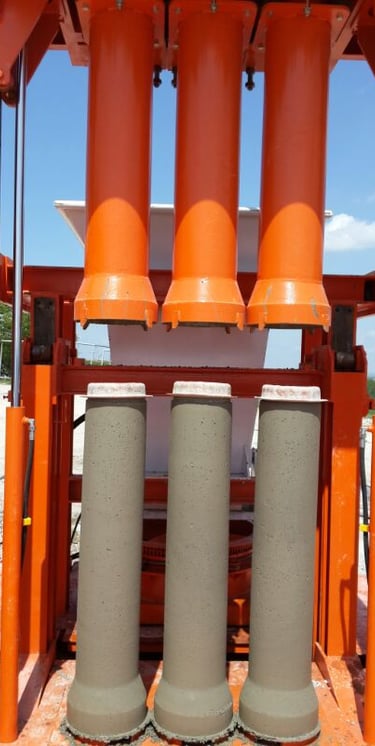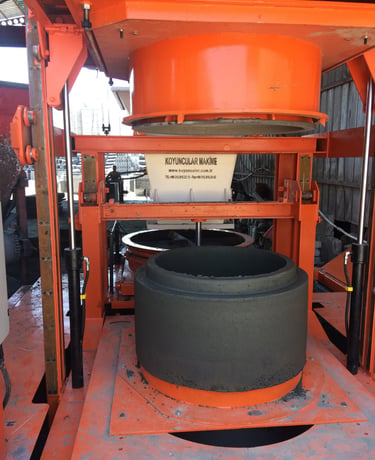Concrete Pipes and Concrete Pipe Making Machines
7/3/20244 min read


Concrete Pipes and Concrete Pipe Making Machines
Concrete pipes are fundamental elements in modern infrastructure, serving essential functions in water management, sewage systems, and drainage. They are commonly used in civil engineering projects such as roads, bridges, tunnels, and buildings. Manufactured with precision, these pipes come in various types and sizes to meet diverse project needs. The production process of concrete pipes is highly mechanized, involving specialized machinery that ensures consistent quality and efficiency. In this essay, we will explore how concrete pipes are made, their application in infrastructure projects, and the types of machines used to produce them. We will also examine the different types of pipes, such as manholes and chimney bracelets.
Manufacturing of Concrete Pipes
The production of concrete pipes involves several stages, including mixing, molding, curing, and testing.
1. Raw Material Preparation: The first step is the preparation of materials, which typically includes cement, aggregates (sand, gravel), water, and additives like fly ash or slag to enhance durability and strength. These ingredients are thoroughly mixed to create a consistent concrete mixture.
2. Molding: The mixed concrete is then poured into molds. Modern concrete pipe manufacturing employs vertical or horizontal vibration techniques to compact the material and eliminate air pockets. This is crucial for producing pipes with high structural integrity. In some cases, reinforcement in the form of steel cages is embedded into the pipe during the molding process, ensuring that the pipe can withstand external pressures once installed.
3. Curing: Once molded, the pipes undergo a curing process to gain the required strength. This typically involves controlled moisture and temperature conditions. Curing can take place in steam or water chambers, or under natural atmospheric conditions, depending on the specific requirements of the pipe. Steam curing is common in factories as it accelerates the hardening process, allowing for faster production cycles.
4. Testing and Quality Control: After curing, pipes are tested for structural strength and durability. Common tests include load-bearing capacity, pressure resistance, and crack resistance tests. Pipes that meet the quality standards are then ready for shipment to construction sites.
Application of Concrete Pipes in Infrastructure Projects
Concrete pipes are widely used in a variety of infrastructure projects due to their durability, strength, and resistance to environmental factors. They play a crucial role in:
1. Sewerage Systems: Concrete pipes are commonly used for sewage systems due to their ability to handle high flow rates and resist the corrosive nature of wastewater.
2. Drainage Systems: In stormwater management, concrete pipes help control and channel water away from populated areas, reducing the risk of flooding.
3. Culverts and Underpasses: Concrete pipes serve as structural elements in culverts, underpasses, and road drainage systems, allowing water to flow underneath roadways while supporting the weight of vehicles above.
4. Irrigation Systems: They are essential in agricultural irrigation networks, transporting water from reservoirs to farmlands.
5. Tunnels and Bridges: Concrete pipes can also be used as part of the foundation or reinforcement in tunnel and bridge construction, offering load-bearing support.
Concrete Pipe Making Machines
Concrete pipe making machines are specialized equipment designed to produce high-quality concrete pipes efficiently. These machines utilize advanced technology to ensure precision in production, high output rates, and consistency in quality. There are several key processes and components involved in pipe-making machines:
1. Feeding and Mixing System: The raw materials (cement, aggregates, water) are automatically fed into the machine’s mixing unit, ensuring a homogeneous mixture.
2. Molding and Compaction: The mixed concrete is transferred into molds, where it is compacted using vertical vibration or centrifugal forces, depending on the type of machine. The compaction is critical for eliminating air voids and ensuring uniform density across the pipe walls.
3. Reinforcement Integration: For pipes requiring additional strength, the machine can integrate steel reinforcement cages into the mold before the concrete is poured. This makes the pipes capable of withstanding higher external pressures, particularly in applications like road culverts and underground tunnels.
4. Curing Chamber: The machines often come equipped with a curing system, where pipes are moved into steam chambers for accelerated curing. This reduces production time and enhances the pipe’s overall strength.
5. Automatic Demolding and Stacking: Once the curing process is complete, the machine automatically demolds the pipes and stacks them for further testing or delivery.
Types of Concrete Pipes
Concrete pipes come in various forms and sizes, each designed for specific applications:
1. Reinforced Concrete Pipes (RCP): These are pipes strengthened with steel reinforcement, commonly used in applications requiring high strength, such as culverts and sewage lines.
2. Non-Reinforced Concrete Pipes (NRCP): These are used in lighter applications, like small drainage systems, where the external pressure is not as demanding.
3. Manholes: Manholes are vertical access points that connect underground pipes and tunnels. They allow maintenance workers to access the system for inspection and cleaning.
4. Chimney Bracelets: These are cylindrical pipes used in chimney construction or other vertical structures. They are designed to withstand high temperatures and environmental stress.
5. Elliptical Concrete Pipes: These pipes have an oval cross-section and are used in areas with limited vertical clearance. They are ideal for shallow burial applications.
6. Box Culverts: Although not strictly a pipe, box culverts are a type of rectangular conduit often used in infrastructure projects to channel water under roads, railways, or embankments.
Conclusion
Concrete pipes are indispensable components in modern infrastructure, offering versatility, durability, and strength. Their production process, involving raw material preparation, molding, curing, and testing, ensures that they can meet the stringent demands of various construction projects. Concrete pipe making machines streamline this production process, delivering high-quality pipes efficiently. The diverse range of concrete pipes—such as manholes, chimney bracelets, and reinforced or non-reinforced variants—ensures that they can cater to the unique requirements of different civil engineering projects. As infrastructure needs continue to grow, the demand for advanced concrete pipes and the machines that produce them will remain essential to the construction industry.


